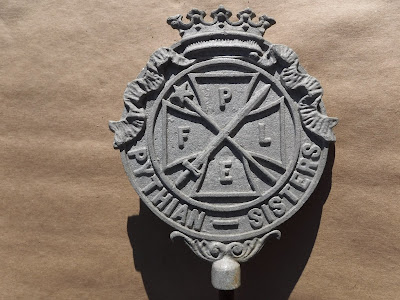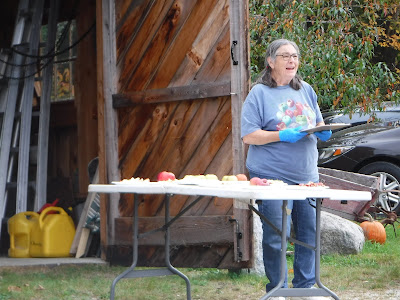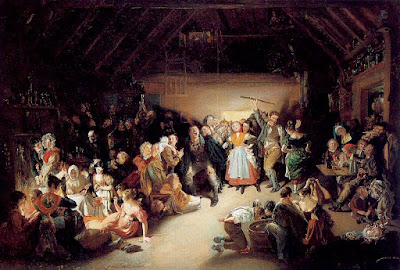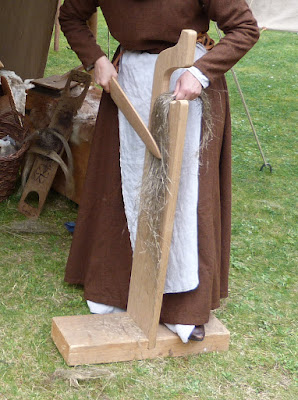Our current display greeting you as you enter the Conway Public Library focuses on "the art of the autumn harvest" and its seasonal traditions. The top shelf features the foliage that brings in buses full of visitors during this time of the year. The "centerpiece" of course is a bouquet of autumn colors, a final blaze of glory before the white of winter.
The image featured at the right of the exhibit label is by Maxfield Parrish who was once a NH summer resident.
It is a self portrait of the artist as Jack Frost, with golden pots of paint to color the leaves all the different tints of autumn. The painting was featured on the cover of Collier's Magazine on October 24th, 1936. The original oil on board is in the collection of the Haggin Museum, Stockton, CA. The library has a number of books on Maxfield Parrish that illustrate his many New Hampshire works and explain in detail his unique approach to art and illustration.
In the back right hand corner of the shelf is a hand-made corn husk doll. The doll is a good example of the old Yankee thrift ethic embodied in the motto "use it up, wear it out, make do or do without!" Corn husks are one of a number of by-products from harvesting a main crop this time of year.
Corn cobs are another by-product of harvesting corn and innovative Yankees found ways to make use of those as well. Like any good artwork, this 1864 painting by Eastman Johnson works on a number of different levels.
A black and white version allows us to examine the details more clearly.
The image compares work and play, young and old, and the subtleties of silent interaction between the two.
More information on the painting can be found
here. Eastman Johnson had ties to the local area. He was born in nearby Lovell, Maine and grew up and painted in Fryeburg.
The next shelf down continues to explore many of the same themes.
On the left is an engraved powder horn. It is a by-product of the butchering process. The powder horn was made from cow horn and used to provide a water proof and spark proof container for gun powder.
To the right of the powder horn is a small promotional magazine called the
New Hampshire Troubadour with a cover showing a hunter with his dog in an autumn setting.
A similar image is scratched into the horn itself.
Above is the hunter with his rifle. Below is his dog.
Presumably, the name of the powder horn's owner was Jess?
... and perhaps he did not even know how to properly spell his own name? This was not uncommon during the period.
The tip was carved to enable a leather shoulder strap and a wooden stopper to be attached to the powder horn.
Jack o' lanterns are another carved seasonal artwork. This painting by Norman Rockwell also explores themes seen in the Eastman Johnson painting above such as young and old, work and play.
The painting
was printed in the 1952 Four Seasons Calendar published by Brown and Bigelow. A charcoal on paper study for the painting is in the collection of the Hofstra University Museum and helps us explore the relationship between a study and a finished work of art. You can learn more about that here.
The tin object shaped like a rocket ship on the right of the shelf is actually a sausage stuffer.
It is missing it's wooden plunger. It works like a large hypodermic needle. While the cow horn is a by-product, the main purpose of fall butchering was to harvest the meat.
Reasons for butchering in the fall include not having to feed as many livestock over the winter and the cold weather helps in the preservation process. Making sausage allows one to combine meats, spices, even apples, improving the taste to one's liking and then by smoking the sausage it can be preserved over the winter.
In front of the sausage stuffer is a scoop made from cow horn. Behind the sausage stuffer is a photo of a corn maze. Farmers of the past would be amazed that today we pay good money to walk through a corn field. To them they only did that as part of their work.
The next shelf down features more seasonally popular produce. On the left is a dipper made from a dried gourd.
Behind and to the left of the gourd is a 1950s era Coca-Cola ad illustrating the game of snap apple.
Here is an earlier depiction of a snap apple party from 1845.
For more information on this painting follow this link
here.
The apple theme is continued on the right hand side of the shelf with Winslow Homer's 1859 print Fall Games - The Apple Bee.
Published in the November 26, 1859 edition of
Harper's Weekly, this print features vignettes illustrating the role of apples in romance, technological change, alcoholism, and supernatural divination. For more information on this print see this link
here.
While this painting by William Sidney Mount may seem to only be a convincingly captured common moment in rural life, it actually has an interesting background as political propaganda. For more info on this painting see this link
here.
The chapter on "The Doughnuts" in this book from my childhood has now became part of our fall family traditions.
The bottom shelf focuses on flax and linen.
A number of tools and techniques used to process flax into linen can be seen in this painting from 1885 entitled
Flax Scutching Bee at the National Gallery of Art. For more info on this painting see this link
here.
For more on flax see our previous blog
here.
We will leave you with this lethal looking device is a heckle, or hackle used in processing the flax plant to linen.
We have only touched on the tip of a tall stalk (metaphorically speaking).
To further explore this and many other historical topics, we offer a free outreach program to local schools and community groups. We can also provide a program via zoom. Please contact us at the Conway Public Library's Henney History Room for more information.
Did you get the point?





















































